Owning a car is a huge responsibility, with car registration being at the forefront. Whether you purchased your dream vehicle or bought one second-hand, registering and renewing your vehicle license at the Land Transportation Office (LTO) is a must.
What with the numerous car owners planning to register their vehicles the same time as you, you know that the process can be tedious and downright arduous. To better equip yourself, make sure to prepare all the required documents and know the procedure.
See the complete guide to registering your car below.

Easy Steps for Car Registration and Renewal in the Philippines
The car registration and renewal process in the Philippines bears similarities to one another. In this process, the only difference you may see and experience is the variety of requirements that will be required by the LTO.
Step 1: Prepare the Documents
To jumpstart the registration process for your new vehicle, start by preparing the essential documents, including the original sales invoice, insurance certificate of cover, original certificate of stock reported (CSR), original PNP-HPG MV clearance certificate, and your tax identification ID.
Imported vehicles are required to bring additional documentation, including BOC certificate of payment, commercial invoice of MV from the country of origin, bill of lading, motor vehicle inspection report (MVIR), and valid certificate of public convenience confirmed by the Land Transportation Franchising and Regulatory Board (LTFRB).
Step 2: Visit the LTO
Once you have all the necessary documents, simply visit your local LTO branch and bring the requirements.
Step 3: Provide all the Required Documents
Once you are at the nearest LTO, submit all the documents to the transaction counter. The evaluator will go over the documents you have provided and will provide a complete breakdown of the fees you need to pay.
Step 4: Have Your Vehicle Tested
An Evaluator will also inspect your car together with the accomplished MVIR form you provided.
Step 5: Pay Your Dues
After the inspection, your name will be called and you will be asked to pay the computed fees to the cashier.
Step 6: Get Your Certificate of Registration
Wait for the Evaluator to call your name. Once your turn is up, proceed to the releasing counter and get your car’s certificate of registration (CR), along with your license plates, RFID, and stickers.
Cost of Registration and Renewal
Below is a list of the fees you need to pay prior to getting your vehicle registration or renewal certificate.
- Initial Registration: P1,000
- Renewal Fee: P400
- RFID Stickers and Tags: P50 each
- Regular Plate Number: P450
- Emission Testing Fee: P400
- Motor Vehicle Inspection Fee: P1,800 for vehicles weighing 4,500 kilograms
- Reinspection Fee: P900
- Penalty Fees:
- Late Registration Fee: P200
- Change of Location Fee: P100
Bear in mind that the cost of registering a vehicle or renewing a vehicle registration greatly depends on the type of car you have, how long you’ve had it, and other similar factors. LTO evaluators will have the last say regarding the amount you need to pay.
Contact Information
The Land Transportation Office has numerous branches. Below you’ll find the contact information for their main offices.
Central Office – Quezon City (LTO Diliman)
LTO Compound, East Avenue Quezon City
1100 Philippines
Telephone Number: 922-9061 to 63
LTO Makati
Butel Building, Pililia Street, Makati City
Telephone Number: 895-8678 or 897-5198
LTO NCR (Cubao)
No. 96 Mirasol Street, San Roque, Cubao, Quezon City
Telephone Number: 440-6424 or 356-0708
Conclusion
With this complete guide to walk you through, car registration and renewal will surely be a walk in the park. If it is your first time, try to be extra patient since these processes might take a huge chunk of your time.
